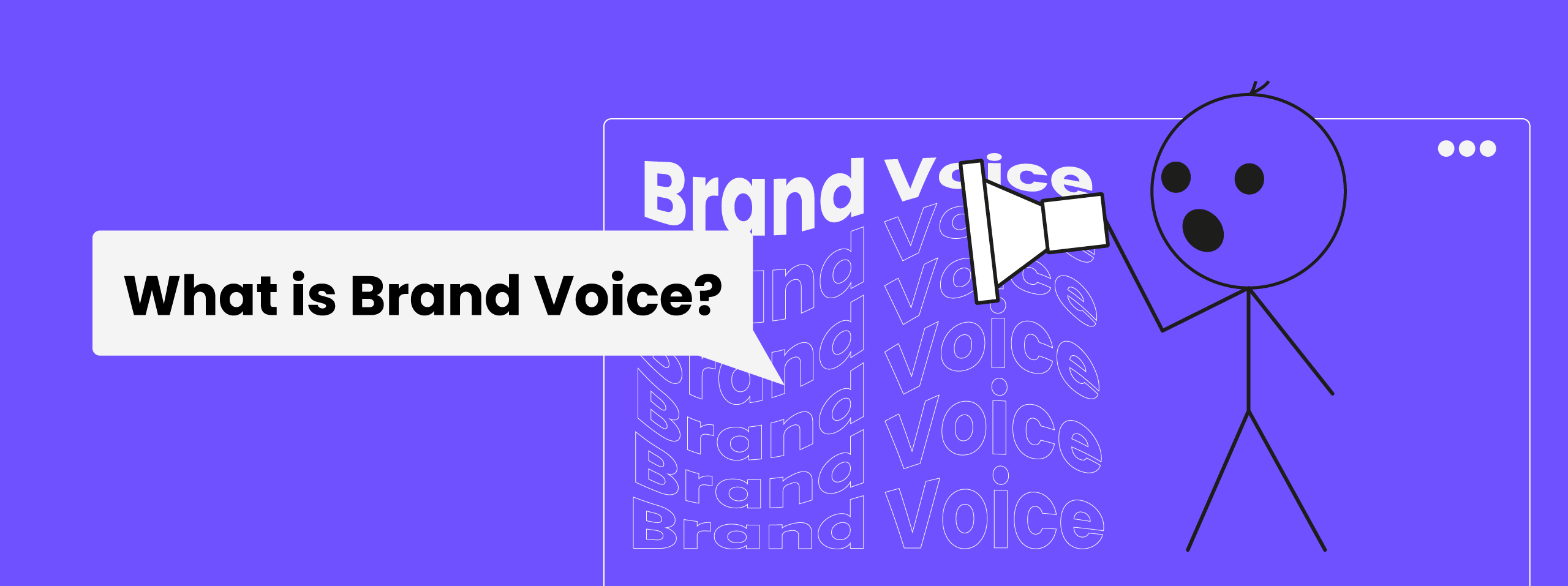Table of Contents
Even though the word “Branding” is now synonymous and familiar to people. For most of us, the first introduction to the word was visual rather than verbal. Well, branding is more than what meets the eye. Many elements are there to branding, like visual branding, brand voice, brand tone sonic branding, and the list goes on. When it comes to business, branding is like a fine wine pairing. If you don’t pair your wine with its perfect ‘food pairing’, congratulations, you have ruined a good bottle of wine.
A key ingredient for your business to thrive is to stand out among your competitors. So engage your audience, build lasting relationships, and increase sales by leveraging your Brand Voice and Tone for your business.

For me, a strong example of a brand identity is “Netflix” and “Ta Dum”. The iconic sound that reaches our ears and minds even before we start to watch anything on Netflix. This is a simple and effective example of creating memorable branding for a business. The two-beat sound bite has become deeply ingrained in our generation. Well, it goes in your mind just as you are reading. The utilization of sonic branding as a strategy emphasizes its effectiveness in improving consumer experience and contributing to the success of a brand.
Now, I am not going down the rabbit hole of what sonic branding is, that is for another day, folks. Let’s get into our wormhole of what brand voice and tone are.
What is Brand Voice?

Now, a quick way to interpret what a Brand tone and Brand voice is
What you say to your audience is a brand voice; how you say it to your audience is a brand tone.
Ultimately, your brand voice is speaking about your brand’s personality through different channels. By targeting the intended audience, build a bridge between your brand and your consumers.
A quintessential example is a host at a gala dinner.
Think your brand is like a host at a gala dinner, and the audiences are the attendees. Now, there is this excitement, expectation, and anticipation among the audience, What would the gala venue be like? What can they expect from the party? As a host, how would the attendees describe you at the party? As a host, are you vivacious, fun, outgoing, or shy? What would you guys talk about? Will the gathering be relatable to your crowd?
Making a list of personality traits can aid in creating a balanced brand voice that is perfect and not overdoing it. To establish your brand voice, you need to put yourself in your audience’s shoes and decide how you wish to be perceived by them. Well, a tone of brand voice can vastly vary based on how an audience listens to it and how they respond to you. Once you have determined that, you should act and communicate in a manner that aligns with your chosen perception.
At what point should I utilize my brand’s voice?
Remember that creating a distinctive brand voice is crucial for any brand to convey its personality and values effectively. It is important to maintain this voice consistently across all communication channels, be it website copy, blogs, newsletters, social media captions, or company emails. A well-defined brand voice helps to inspire and engage your audience and can leave a lasting impression of your brand’s unique identity. It isn’t rocket science to create a compelling brand voice; it just takes a bit of creativity and consistency.
What is a Brand tone?

A brand tone is a combination of your brand personality and brand value. In light of branding and marketing, tone of voice refers to how a brand intercommunicates with it’s customer or audience through messaging and interactions. It is similar to how we speak from person to person. The way we communicate may change, but neither our personality nor our values will change. The tone would represent a brand but also may differ based on various factors, such as the intended audience, target persona, communication channels, and the customer’s position in the product purchase journey.
Setting a tone for a store is not something that you should take lightly. As it can aid in differentiating a business from the crowd of other store owners and communicating its brand values to its customers.
Another ideal example is how you talk to an important business partner, and the tone set will be formal, poised, confident, and professional. But what if you are texting your best friend, most probably friendly, informal, and casual? Well, if we analyze both cases, your personality and values, which are your brand voice, don’t change, and how you convey it to your consumers is the brand tone that changes.
So how do you want your brand tone to be, “Happy or Cheerful,” “Sarcastic or Peppy,” and “Curious or Conscious”? Just like how we interpret in the real world, when it comes to brand tone, the way you convey it can take on a complete turn of meaning depending on your audience and how you say it.
Your Brand Voice should reflect you.

Getting lost in a comparison trap can be quite easy. Quite a lot of good stores bring unique brand voices to concepts in a brilliant and creative way that can reach every kind of consumer base. The message set for reaching the audience is always clear and precise as they intricately weave the concepts and personalities in a pleasing way that emulates their voices. Often, we forget what is very important when it comes to brand voice it’s that the tone you set for your brand should be unique. If you sound like another brand, that is not going to help you reach anywhere.
It is vital yet challenging to express yourself in a voice that doesn’t feel like your own. A thing I do when I am working with brands is to consciously dissect and analyze other brand voices. Remember that your voice is unique, authentic, and valuable, and it’s okay to take the time to find the right words to convey your message.
Creating an Authentic Brand Voice and Brand Tone
There are many brand voices and tones out there, and it’s common to find a brand that sounds similar to yours. This can be confusing. But do remember that the way something is created is not limited to one person’s method. It could take time, patience, and practice to nail your brand voice. There are times that I would go into the black hole of writing several verses or lines and end up deciding, well, this isn’t what I want this brand to sound like. Now, having this consciousness and awareness will help you in boundless ways. Staying true to your brand and wanting it to genuinely sound like how you want your audience to hear you is like an argonaut’s golden fleece when it comes to branding.
Now that I have given you a clear picture of what a brand voice and tone is, I’ll help you how to find yours.
Have an in-depth understanding of your brand to apply brand voice .
The first step in order to define your brand voice is to be aware of your brand. If you don’t have the faintest idea about these certain questions about your brand,
- Why does your brand exist?
- What is your brand’s purpose?
- How are you going to deliver your offering?
- How are you unique from the other similar brands in the market?
- How are you going to make your audience understand where you come from and your values?
Well, you have to retrace back to the beginning and figure these out first.
When it comes to a brand, there is a brand persona. It is a combination of several components like visual imagery, design, purpose, experience, and brand voice. Here, an important fact that you have to consider is that the brand voice should correlate with the other components of your brand persona.
Your Brand Stories Matter
A key element that defines a brand is its brand story. Incorporating personal stories in your writing can aid in establishing an authentic and meaningful bond among your listeners or readers. Your brand story helps build a rapport with your audience and can give a clear idea of the technical details you may be discussing.
If you are dealing with a common topic, chances are that it has been addressed before. However, if you feature a narrative that is drawn from your genuine personal experiences, it will always be one-of-a-kind and legitimate.
Nobody would like to listen to a robot.
This is quite basic for any writer and it is important to keep in mind that, at times, this is for those who have the propensity to go on a writing rampage. This can manifest as either going overly formal when discussing complex subjects or becoming too verbose in one’s writing. It is crucial to be aware of this tendency and strive to maintain clarity and simplicity in one’s writing. One of the main reasons why readers usually prefer gossip over a long-form article is that it is short, crisp, and conversational. Just like that, while setting a brand voice or a brand tone, it should be more personable and relatable to the audience.
A simple way to figure out the quality of your written content is to read it aloud. Analyze a few things here: does it sound like you, or is it boring? If not, consider rewriting it. Making it more humane by setting up a conversational tone can make your content more easy to relate and engaging.
3 Words to Remember – Simple, Relevant & Consistent
Now, you are writing for all kinds of audiences. And they don’t have to be very fluent in industry jargon. I say take a chill pill and keep it simple, clean-cut, and relevant. Don’t complicate it. Yes, we know you are fluent, but your audience might not have to be. I have encountered many product descriptions where complex language is used to explain the product. Rather than making you sound like someone who has a good command over your language, it might not suit the brand tone.
Another problem that can arise is if it is a technical subject. By using complex language, your audience might not understand what you are trying to convey. So, keep it clear, crisp, and concise. Make a conscious decision about your preferred way of speaking and try to maintain consistency as much as possible.
Being consistent is about more than the amount of content you produce alone but the consistency of the tone you keep while referring to your audience. Do you call your audience “clients,”” customers,” “patrons,” or anything else? To effectively communicate with your customers about your brand. It is imperative that you give careful thought to your language choices. Now consider whether you prefer using first-person pronouns like “I” or “we” or if you tend to speak in the third person. Always address your customers directly with “you” and “your,” and avoid referring to them in the third person. Moreover, pay attention to the words, phrases, or even emojis you frequently use. By considering these factors, you can establish a clear, consistent, and powerful communication style.
Have an Opinion
It’s important to remember that your perspective and opinion carry the same weight as anyone else’s. Whether or not your ideas are creative, they will be appreciated by those who are receptive. It’s perfectly fine if others don’t share your views. You can leverage your well-crafted brand strategy, including your vision, purpose, and values, to confidently apply to your Woocommerce Store. Wanna apply all you learned into a business, i say you check this out
Long Story Short
Being a writer, I struggled with finding the right tone of voice for different brands. But with time, I improved, and so can you. Striving for the ‘perfect’ voice and tone is a bit unrealistic and limiting. Developing your voice is an ongoing process that requires practice. There were times you might spend a lot of time refining your blogs or any other content. Which is never going to feel nearly perfect. I would still say put them out into the world with the hope that they will help others. That is what really matters.
At times, we all devote time and effort to each piece we work on. It’s important to acknowledge that you have created something thoughtful, purposeful, and well-considered to the best of your current knowledge. Avoid striving for perfection, as it may hinder the development of your voice. Instead, let your voice flow and shine!











 THANK YOU!
THANK YOU!